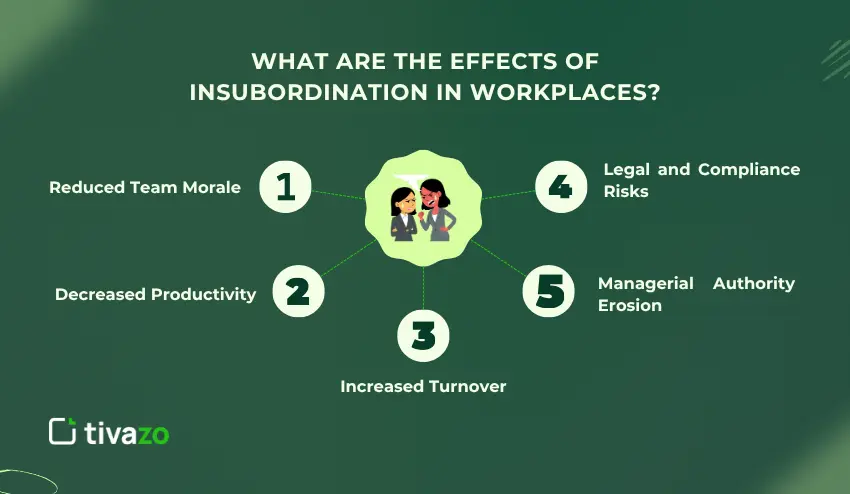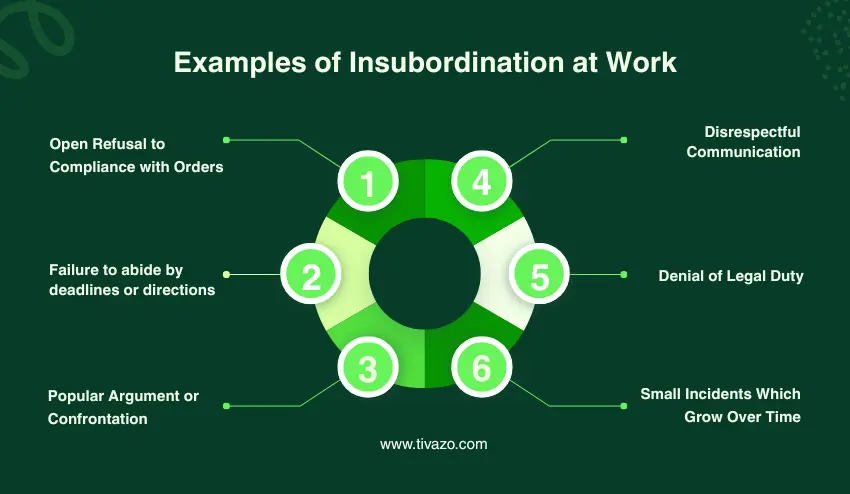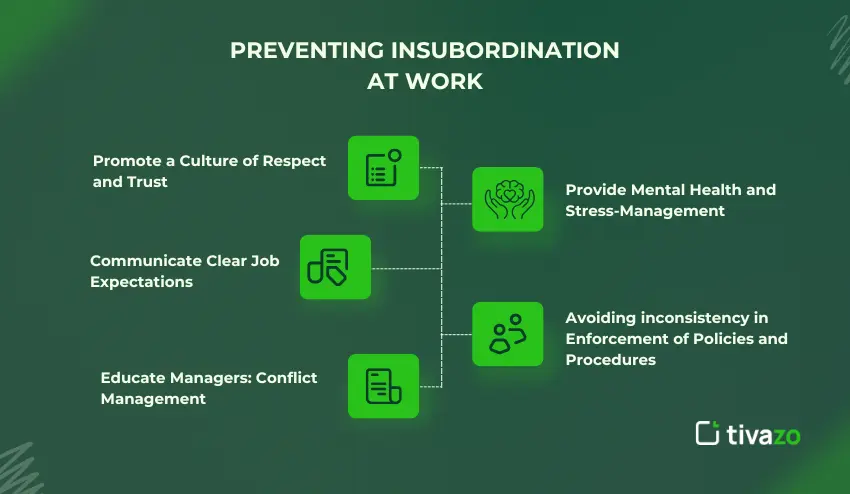Respect and cooperation are the pillars of a healthy working environment in any organization. However, there are occasions when an employee can go against authority or disobey. Once this disobedience transcends mere disagreement, it is insubordination in the workplace.
Insubordination at work does not simply occur once as an act of frustration, but it is a direct rejection of performing reasonable orders or showing disrespect to a supervisor. It may disrupt the workflow and hinder morale in the team, whether it occurs in the form of open argument, refusal to do duties, or disrespectful communication.
It is important to know what insubordination at work is to enable employers and employees to ensure a fair and professional environment. It is knowing the thin line between defending oneself and disrespecting authority. Here, we shall discuss the nature of insubordination, the reasons why insubordination occurs, and how to manage it in a way that prevents it before it becomes a larger problem.
What Is Insubordination at Work?

Insubordination at work occurs when an employee willingly declines to comply with a lawful and reasonable directive issued by a manager or supervisor. It is not about a healthy disagreement or voicing opinions but it is about defiance that is open and challenges the authority at the workplace.
To illustrate the point, when a manager requests an employee to do a report by the end of the day and the employee responds, I will not do it and you cannot make me do so, it is obvious insubordination. The denial is deliberate, and it goes directly against the authority of the manager.
Different forms of insubordination may exist. It may be verbal, like insulting a supervisor or yelling at him/her. It is also behavioral such as disregarding a direct command or storming out in the middle of a discussion. Non-verbal behavior, such as rolling eyes, not responding to messages, or simply taking unnecessary time to do something can also be regarded as insubordination at work , albeit it is subtle.
Not all disagreements, however, amount to insubordination. Employees are entitled to challenge ambiguous instructions, raise ethical issues or decline unsafe and unlawful tasks. This is the reason why it is important to comprehend the context of every situation before calling it insubordination at work.
What Causes Insubordination at Work
Insubordination at work does not come as an overnight event in the workplace, it is normally a culmination of a certain tension, miscommunication or ineffective management styles. Knowledge of such underlying causes enables leaders to deal with the problem at an early stage before it can develop to open defiance.
1. Poor Communication
One of the greatest causes of insubordination at work is miscommunication. Lack of proper clarity, specificity and timely instructions given by managers can lead to misunderstanding of expectations or misperception that employees are being judged unfairly.
- Confusion is caused by vague directions.
- Absence of context may lead employees to ask themselves how decisions are made.
- Lack of consistency in feedback results in frustration.
Such misunderstanding can start becoming resistance easily, not due to the desire of the employees to oppose the authority, but because they feel that no one is listening to them or people do not understand them.
2. Lack of Respect or Trust
Mutual trust is the key to a healthy work relationship. When employees feel that their bosses are unjust, dictatorial or disapproving, there are high chances that they will rebel against the authority.
This may eventually result in open disobedience, particularly where workers have been looked down upon in the presence of others or overlooked when they are being consulted.
3. Unresolved Workplace Conflicts.
Whenever disputes among team members or departments are not addressed, tension develops. Insubordination at work is also a means through which employees can be able to show their frustration or to resist what they perceive to be unfair leadership.
This is particularly prevalent in those kinds of environments where the managers do not want to discuss interpersonal problems, and resentment builds up.
4. Personal Stress or Emotional Strain.
Personal problems such as family problems, financial problems or burnout may leak into the work place. When employees are stressed, they tend to respond emotionally to instructions or criticism.
Although this does not justify the insubordination, it demonstrates that the emotional well-being has a direct impact on behavior in the workplace.
5. Lack of Consistency in the Rule Enforcement.
Unfair application of rules makes the employees lose confidence in the system. When one employee does not receive any punishment after disobeying a command, other employees will also do the same.
Unreliable discipline conveys the message that the authority is not to be trusted and invites more defiance and undermines morale in the workplace.
Insubordination at work is not in most instances an indication of rebellion, it is an indication of communication failures, gaps in leadership or lack of consistency. Recognizing these early will allow organizations to take remedial measures and ensure that minor problems do not turn into a big problem.
What Are the Effects of Insubordination in Workplaces?
Insubordination at work is not only an issue to an individual employee, but also to the team and the organization. The effects it may have are either short term like workflow disruption or long term like reduced employee retention and morale. The knowledge of these effects enables leaders to act in a strategic manner instead of acting in a reactive manner.

1. Reduced Team Morale
Defiant behavior may have the effect of spreading tension to a team. When team members observe a colleague who declines work or challenges the management authority, he or she can be frustrated, demotivated, or even anxious about his or her own duties. In the long run, the team cohesion will be lost, cooperation will decrease, and the employees might lose interest in working on group projects.
Example: When a single team member does not update a shared report on time, the rest might be forced to cover the slack, which will result in resentment and a lack of desire to assist in the future.
2. Decreased Productivity
Insubordination at work has a direct effect on workflow and efficiency. Activities could be postponed, time lines could be broken and resources could be squandered. Even minor acts of insubordination, such as not responding to emails, not working as fast as necessary, or not accepting more duties, can have a strong negative impact on the overall team output.
Example: A project is late due to a critical employee who does not want to accomplish a task that is required. This does not only impact on that project but also may cause backlog in other dependent projects.
3. Increased Turnover
Once the insubordination is a habit, the high performing employees tend to develop the impression that the work environment is not just unprofessional but also unfair. This discontent may push skilled employees to find jobs in other companies, which will increase the turnover. The high turnover of employees destroys teams, raises the recruitment expenses, and compels managers to keep training new employees.
Scenario: An employee has a habit of disregarding safety protocols. Other team members might feel unsafe or unsupported and they will leave even though they would have been satisfied with their positions.
4. Legal and Compliance Risks
Some acts of insubordination at work can be beyond the law. The organization can be subjected to lawsuits or regulatory fines because of threats, harassment, or intentional breach of organizational policies. Firms should be keen to record the incidents and adhere to the set HR and legal procedures to prevent any liability.
Scenario: A worker declines to use the required safety measures openly, posing a potential occupational risk. Lack of this may lead to OSHA fines or law suits in case of an accident.
5. Managerial Authority Erosion.
Toleration of insubordination at work is a way of compromising the credibility of the leadership. Employees can start doubting the decisions made by managers, disobeying orders and openly criticizing policies. This can give a culture of optionality in rules and the managers have difficulties in enforcing even simple procedures.
Scenario: When one worker constantly declines to attend mandatory team meetings and there is no action taken on the same, the other team members might also do the same and managers may find it extremely hard to keep the order.
In brief, insubordination at work may demoralize, decrease productivity, turnover, cause legal problems, and undermine authority among managers. It is important to tackle it as soon as possible and in the most effective way to have a healthy, productive and law-abiding workplace.
How to Address Insubordination at Work
Effectively addressing insubordination at work requires a structured approach that balances authority with fairness. It is not merely to correct the behavior but to preserve the trust, morale and productivity within the team. The following are the steps that managers and HR professionals can follow.
1. Calm down and Evaluate the situation.
In situations where there is insubordination at work, one must always stay calm. Emotional response can increase the conflict. Take time and watch the behavior keenly and find out whether it is a single episode or a trend.
Scenario: An employee does not want to attend a compulsory training session. The manager researches on the reasons behind the refusal before responding; to find out whether it is because of misunderstanding, lack of time or deliberate defiance.
2. Confirm the Instruction was Understandable and Reasonable.
In other cases, lack of clarity or unreasonable instructions is the cause of insubordination. Ensure that the assigned task is specific, attainable and within the scope of the employee. Make sure that the employee was well aware of what was required.
Scenario: A manager requests a report before Friday. In case the employee states that he/she has not understood the deadline or scope, explaining expectations will avoid conflicts in the future.
3. Document the Incident
Proper documentation is necessary. Write down what, when and who. Additional evidence like emails, messages, or witness testimonies. This makes it transparent and safeguards the two parties in case any further action is necessary.
Tip: Have a special HR record of behavioral incidents to monitor trends with time.
4. Have a Private Conversation with the Employee.
Having a private conversation will allow you to address an insubordinate employee without embarrassing or justifying yourself in front of others. Maintain your professionalism and talk calmly about the behavior you saw, the associated impact of the behavior, and what you expect moving forward.
Sample Script: I have noticed that you did not finish the task as you were supposed to do. That affects the deadlines of the team. What is your take on this so we can find a way forward?
5. Enforce Company Policy in a Consistent manner.
Adhere to the agreed disciplinary measures, be it a verbal warning, written warning or official intervention of the HR. Consistency eliminates unfairness and avoids the inclination to favoritism.
Example: When a verbal warning is customary in the case of first-time insubordination at work, it should be used on all employees in the same case.
6. Provide Support or Coaching where necessary.
There are instances of insubordination that are associated with skills gap, stress or lack of understanding. Guidance, training or mentoring can help to rectify behavior without the conflict escalating.
Example: When an employee declines a new software task, give a brief training session to develop confidence and compliance.
7. Contact HR and/or Management When Necessary
There may be times when informal means of correcting behavior are unsuccessful and HR and/or management must be involved. To do so, be sure you have a formal PIP, mediation process, or corrective action.
Example: An employee is unsafe or does not follow safety protocols or procedures. After documenting your coaching and co-worker warnings about the behavior, HR may put together a formal PIP to outline the processes for disciplinary action if the employee is unable to comply.
Examples of Insubordination at Work
Identifying insubordination at work can be challenging because it sometimes overlaps with normal disagreement or stress-related behaviors. Through looking at real-life cases, you are more likely to tell the difference between defiance and misunderstanding and act accordingly.

1. Open Refusal to Compliance with Orders.
It is the most direct way of insubordination at work. When a worker directly declines to obey a legal and sensible order, it questions the authority of a manager and interferes with the working process.
Example: A project manager gives one of the team members a presentation to a client that is required within two days. The employee replies, I am not doing it. It’s not my job.” Such rejection compels other members of the team to pay up, postpones project schedules, and weaken the leadership of the manager.
Why it is important: Open refusal is an indication of lack of respect and it is easily contagious when other employees witness that there are no repercussions to defiance.
2. Failure to abide by deadlines or directions.
Ignoring repeated instructions or deadlines is another common form of insubordination at work. Although the employee may finish the task at the end, the delay may impact on the team productivity and morale.
Example: An HR employee is requested to update employee records on a weekly basis. They always do not reply to emails, never file the updates and never give an explanation. There are delays in the payroll team and this creates frustration and tension among the departments.
Why it is important: This form of defiance is passive and it may damage trust in the long run and must be well documented to be dealt with.
3. Popular Argument or Confrontation.
It is especially destructive to confront authority in the presence of co-workers. It does not only weaken the manager but also gives other employees a poisonous environment.
Scenario: An employee is having a staff meeting with his supervisor, where the employee yells at the supervisor, ignores the supervisor, and declines to take part in the given project. Other team members are uneasy and afraid to express themselves, which decreases the general involvement.
Why it matters: Public insubordination at work can escalate quickly, damaging morale and setting a precedent for others to challenge authority.
4. Disrespectful Communication
Words carry weight. Sarcastic, rude or dismissive verbal or written communication is insubordination, although the work might be done.
Example: When an employee receives a task assignment, he/she responds with: I do not see why I have to undertake this meaningless work, nevertheless, I will do it. Such a language is a form of disdain and it reduces the unity of the team.
Why it is important: Inappropriate communication can cause tension, damage relationships between professionals, and can result in more significant conflict when neglected.
5. Denial of Legal Duty.
Insubordination at work also involves the rejection of the tasks that are reasonable, legal, and within the job description of the employee.
Scenario: A warehouse worker does not want to adhere to general safety inspections. Even after being reminded, the employee says, “It is not necessary. I won’t do it.” This is not only against the company policy but may also cause safety hazards.
Why it is important: The refusal to perform legal jobs influences the compliance, safety in the workplace, and the company may be liable.
6. Small Incidents Which Grow Over Time.
Even seemingly small behaviors can indicate insubordination at work if they occur repeatedly. These are rolling the eyes, sighing, not listening to messages or deliberately procrastinating.
Scenario: One of the team members never responds to non-urgent emails and delays minor tasks. In the long term, the cumulative effect will reduce the speed of a team and irritate colleagues, ultimately becoming a major distraction.
Why it is important: Small signs left unattended may become normalized and prompt more severe insubordination within the team.
Preventing Insubordination at Work
It is always better to prevent rather than to react. Through provision of a conducive and well-organized working environment, organizations are able to reduce the chances of insubordination and ensure that teams remain productive. Prevention measures are based on clarity, communication, leadership and employee engagement.

1. Promote a Culture of Respect and Trust.
A place of work that is characterized by respectful employees will have less chances of insubordination. The sharing of trust between the managers and the staff fosters cooperation and minimizes friction.
Example: When managers frequently recognize the contribution of employees and give them constructive feedback, they make employees more willing to follow instructions.
Practical Advice: Organize frequent team meetings, during which employees are able to express ideas and concerns without being judged, as it will strengthen a culture of respect.
2. Communicate Clear Job Expectations.
When job roles and responsibilities have been communicated clearly, employees will not typically fight with those in authority. Uncertainty in job duties or expectations can lead to ambiguity, exasperation and defiance.
Example: A supervisor communicates a clear project scope, with deadlines, deliverables and reporting functions. The employees understand the expectations and are more likely to adhere to the performance of their roles.
Practical Tip: Update job descriptions regularly, and ensure all employees can articulate what their job is.
3. Educate Managers: Conflict Management.
Managers should be equipped with the tools, skills and tactics on how to address defiance and conflict. Training in distracting listening, de-escalating, and communicating meaningful feedback will greatly reduce the probability of Defiance in the work group.
Scenario: A supervisor determines there is collateral damage, in a team meeting. They use their conflict management training, to resolve the friction before any displays of defiance occur.
Practical Tip: Conduct workshops or coaching to managers to enhance leadership and communication skills.
4. Provide Mental Health and Stress-Management.
Insubordination is largely caused by workplace stress. Mental health, stress management, and work-life balance resources can assist the employees to cope with the issues without venting out their frustrations with defiance.
Example: Workers can receive counseling services or wellness programs, which minimizes emotional responses that may cause insubordinate behavior.
Practical Tip: Uphold frequent breaks, offer flexible working schedules, and encourage well-being programs among employees.
5. Avoiding inconsistency in Enforcement of Policies and Procedures.
The inconsistency in enforcement of rules may bring confusion and resentment. The more the policies are fair, transparent and in a regular fashion, the more employees will respect authority.
Sample: When two workers commit the same petty offense, the two are given similar punishment. This uniformity promotes equity and minimizes favoritism.
Practical Tip: Have disciplinary processes documented and make all managers adhere to the same process.
How to Resolve Insubordination at Work
Even with clear rules and positive culture, insubordination at work can still happen. Once it does, the most important thing to do is to deal with it in a cool, just and timely manner before it gets out of control or destroys the morale of the team. It is not only about punishment but rather about the restoration of mutual respect and avoiding problems in the future.
Here’s a detailed look at how to effectively handle insubordination in the workplace.
1. Stay Calm and Objective
Emotions may easily get out of control when an employee refuses to follow the instructions or acts disrespectfully. However, the response to anger will just worsen the situation.
Sample: When an employee yells in a meeting, the manager should not react in the same enthusiasm. Rather, stop the discussion and resume it in the privacy of the two individuals after both have calmed down.
Hint: Do not confuse the act with the actor. Discuss what has occurred, not who they are. This assists in maintaining the focus on resolution as opposed to individual conflict.
2. Collect Facts and then Act.
It is necessary to research the incident before making assumptions. It is possible that there are legitimate reasons that led to the defiance such as lack of clarity in instructions, personal stress or lack of understanding.
Example: An employee who skips a task may have skipped because he/she was overworked and not because he/she disrespected him/her.
Hint: Record the scenario – dates, witnesses, and verbatim behavior. This is beneficial in making sure there is fair evaluation and prevents bias.
3. Discuss the Issue Privately
Do not address an employee on insubordination in front of others. This might embarrass them and cause the situation to be worse. Open and honest communication is possible during a private meeting.
Sample: The manager takes the employee to a quiet place, tells the employee about the observed behavior and requests the employee to give his/her side of the story. This usually results in perception instead of confrontation.
Tip: Use I statements rather than You statements. For instance:
Rather than: You disrespected me.
Attempt: I was offended when you left the meeting.
4. Listen to Their Perspective
A case of apparent insubordination may be caused by miscommunication or underlying discontent. Listening demonstrates empathy and in most cases, it exposes the underlying factors which may include stress, burnout or not knowing what is expected.
Examples: When an employee refuses to follow an order, he or she may feel that he or she was not provided with sufficient information or resources to accomplish the task. Managers can detect these barriers early with the help of listening.
Tip: Encourage honesty. Ensure that the worker is aware that it is a talk of improvement, not of punishment.
5. Restatement of Company Policies and Expectations.
Once the situation has been determined, remind the employee about the code of conduct and standards of behavior in the company. This is to provide a sense of clarity and establish guidelines in the future.
Example: A manager may say, our policy is that professional communication should always be used. In future, please make disagreements respectfully.
Hack: Be professional and solution oriented. Do not refer to irrelevant past errors.
6. Determine Appropriate Disciplinary Measure.
When the action is severe or repeated to the extent of action, then you might want to contemplate disciplinary measures such as verbal reprimand, suspension or termination depending on the policy of your company.
Example – Once you have issued a number of warnings to the person to stop defiance, a written notice must be issued to record that you have done something about the recurrent behavior.
Reminder: In such cases, it is always better to refer to the HR guidelines of your company and prevent a potential legal or ethical problem. Also remember to record all disciplinary action taken.
7. Re-establish the Working Relationship.
Once the problem has been solved, work on restoring trust. The intention should be to reestablish professional collaboration and avoid the presence of resentment.
Example: A manager follows up on the employee after a disciplinary meeting after a week to make sure that communication has been improved and that the employee feels that he or she is supported moving forward.
Tip: Coach or mentor the employee to get him adjusted and re-integrated into the team.
8. Learn from the Situation
Every instance of insubordination can be learnt as a lesson to better the management practices. Consider what caused the behavior, was it a miscommunication, bad workload management or an unrecognized person?
Example: When several employees resist in the same way, this can be a leadership or process problem and not individual resistance.
Note: Take the lesson learned to empower policies, improve communication and create a healthier team culture.
What Is the Difference Between Insubordination and Misconduct?
Although insubordination and misconduct are used interchangeably, they are different behaviors in the workplace and must be treated differently. The knowledge of the difference assists managers to react accordingly and justly.
Insubordination
Insubordination is a situation when an employee does not want to obey the legal orders, openly opposes the authority, or disrespects a supervisor. It is normally focused, goal-oriented, and task-oriented.
Example: When the employee is asked to do a report, he/she declines to do it and says, I will not do it. This is an open confrontation with authority and does not always violate any law or company policy outside the immediate command.
Key Traits:
- Failure to obey reasonable orders.
- Open disobedience of a manager.
- Task or authority focused
- Frequently solvable by means of discussion, coaching or disciplinary measures.
Misconduct
Misconduct is also more general and encompasses any action that contravenes the company rules, policies, or the law, with or without them questioning authority. Misconduct may consist of stealing, bullying, dishonesty, or constant carelessness.
Examples: An employee keeps on falsifying expense reports or committing harassment. This is not just defiance, but it can involve legal or HR action.
Key Traits:
- Violates policies or laws
- May or may not have authority defiance.
- May have severe legal or ethical impact.
- Frequently leads to disciplinary or lawsuits.
Comparison Table: Insubordination vs. Misconduct
| Aspect | Insubordination | Misconduct |
|---|---|---|
| Definition | Refusal or defiance of lawful instructions | Violation of company rules or law |
| Focus | Authority or task | Policies, ethics, or legal compliance |
| Examples | Refusing a task, disrespecting a manager | Theft, harassment, fraud |
| Resolution | Coaching, discussion, warnings | HR intervention, disciplinary action, legal response |
| Severity | Usually situational, less severe | Often serious, can lead to termination or legal consequences |
What Is Not Insubordination at Work?
Not every disagreement or refusal will be insubordination at work. Here’s what doesn’t qualify:
- Making decisions on the basis of expertise or ethics.
- Seeking clarification or asking questions: Requiring information in order to do something properly.
- Rejection of unsafe or illegal work: Guarantees the safety of the employees and legal compliance.
- Professional expression of concerns: Providing feedback or moral contribution in a respectful manner.
- Good faith mistakes or omissions: Accidental mistakes not accompanied by insubordination.
Conclusion
Insubordination at work can disrupt teams, lower productivity, and strain professional relationships. Knowing the reasons, the warning signs, and the effective strategies enable managers to deal with the behavior and still have a positive workplace culture. Insubordination refers to the deliberate disobedience of a legal order or authority that is usually caused by ineffective communication, disrespect, unresolved disputes, stress, or inconsistent rules. It is much better to prevent a problem by setting clear expectations, respecting each other, training leadership, and having consistent policies than reacting to the problem when it occurs.
In cases where problems arise, it is better to solve them amicably through confidential conversations, adequate recordings, and reasonable punishment to bring professional sanity. Being straightforward, fair, and consistent when dealing with insubordination helps preserve the morale of the team, maintains productivity, and provides a respectful workplace.




